Disclaimer: This post includes an affiliate link.
The Linked Double Crochet Stitch, abbreviated LDC, is a great stitch to have in your roster. It's got the height of double crochet stitches, but because each stitch is linked, or joined in the middle of the post, you don't get the holes and gaps you get with standard double crochet stitches. It creates a much more solid fabric than double crochet, without the thickness or stiffness of single crochet. Here's how it's done!
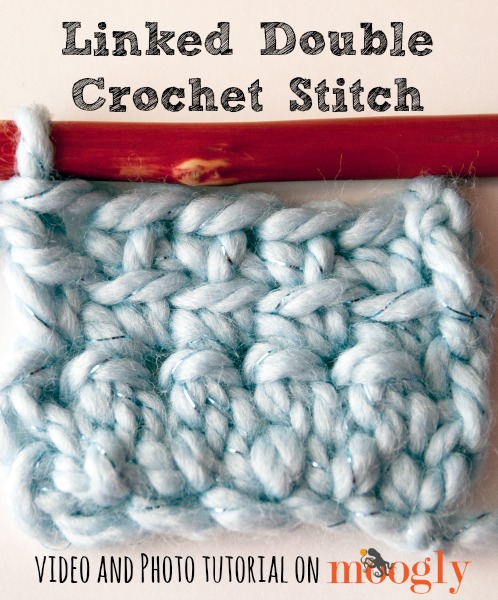
Disclaimer: This post includes an affiliate link.
Linked Double Crochet Video Tutorial
Linked Double Crochet Photo Tutorial
The video and photo tutorial feature Lion Brand Thick & Quick in Mystical; the photos feature an N (10mm) hook from Craftwich Creations.
The Linked Double Crochet stitch can be worked over any number of stitches. To start, chain the desired number of stitches, and then ch 3 more.
To make the first Linked Double Crochet in the foundation chain: Ch 3 and insert the hook in the 2nd ch from the hook. Yo and pull up a loop.
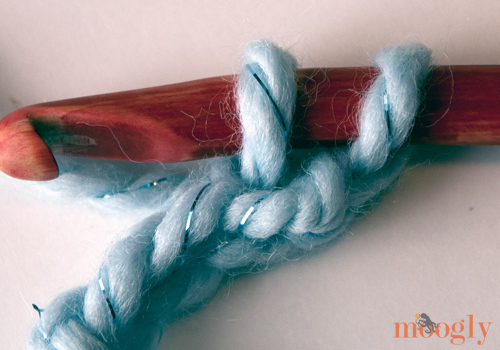
Insert the hook in the 4th ch from the hook, and yo and pull up a loop.
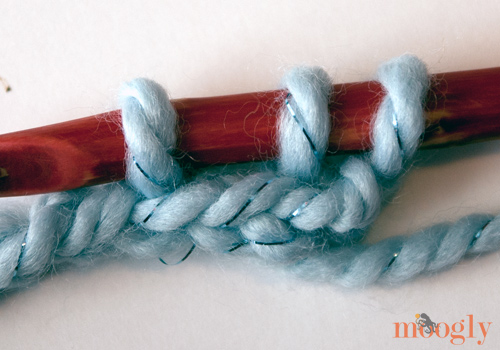
Yo and pull through the first two loops on the hook, yo and pull through the last 2 loops on the hook (as for a regular double crochet).
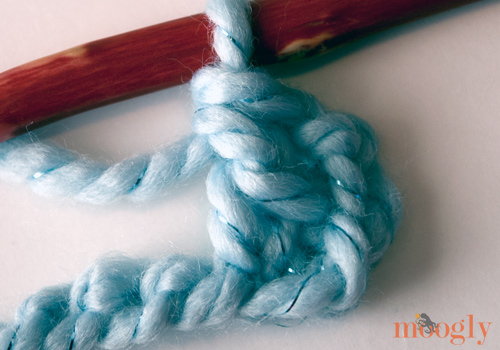
*To make the next Linked Double Crochet: Insert the hook down through the horizontal bar in the center of the stem of the previous stitch, yo and pull up a loop.
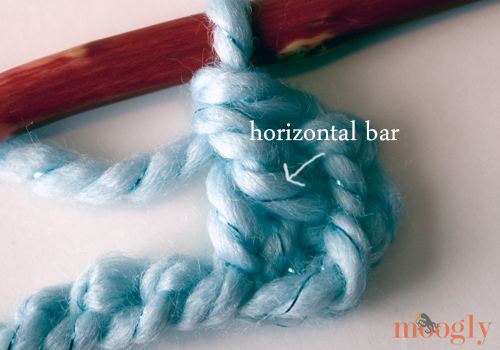
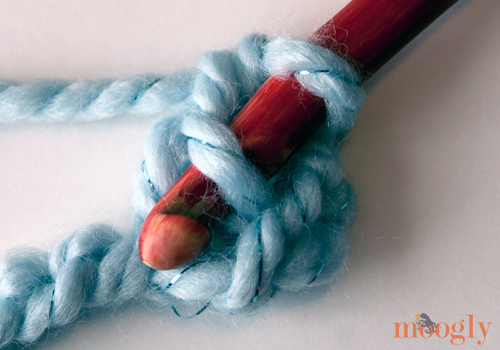
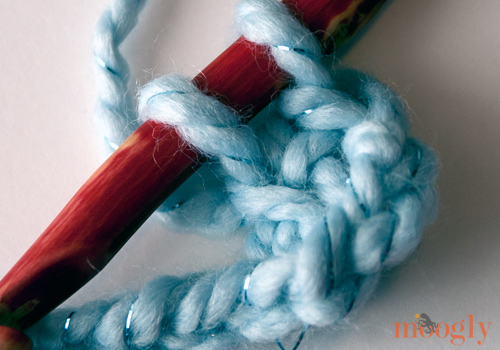
Insert the hook into the next chain, and yo and pull up a loop.
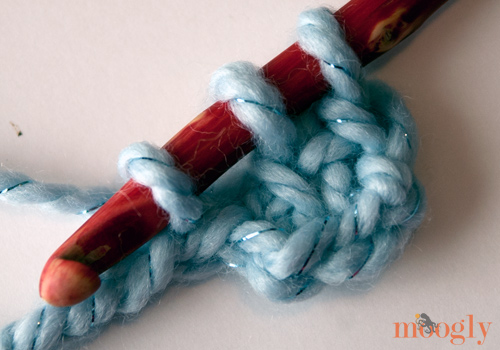
Yo and pull through the first two loops on the hook, yo and pull through the last 2 loops on the hook.
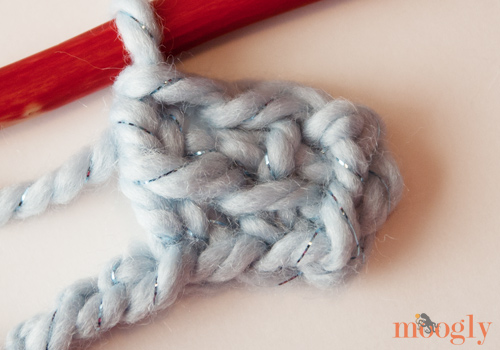
Repeat from "*To make the next Linked Double Crochet" to the end of the chain (or as indicated).
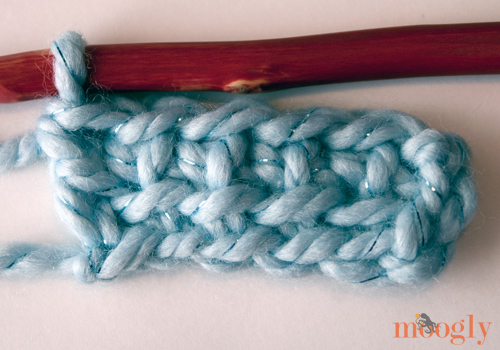
To start the next row of Linked Double Crochet: (Turn after the previous row.) Ch 3 and insert the hook in the 2nd ch from the hook. Yo and pull up a loop.
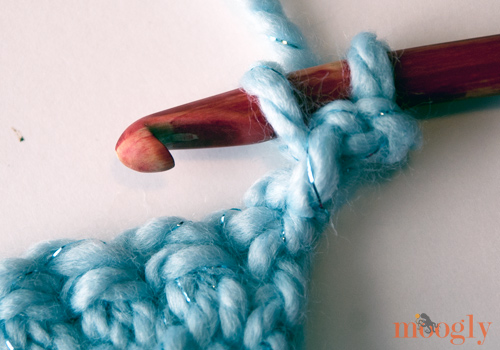
Insert the hook in the first st of the row, and yo and pull up a loop.
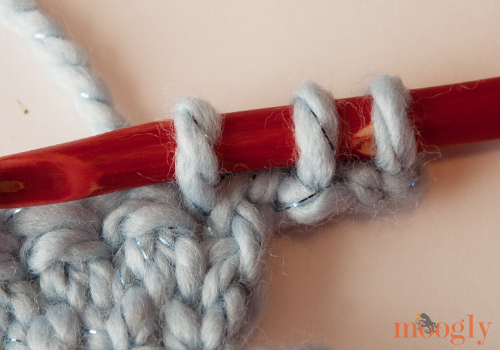
Yo and pull through the first two loops on the hook, yo and pull through the last 2 loops on the hook (as for a regular double crochet).
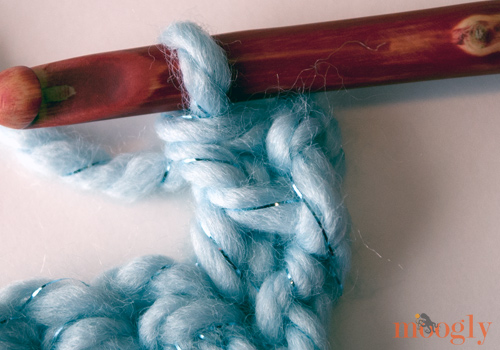
Continue along the row as for the next Linked Double Crochet above, working into each subsequent stitch (or as indicated).

Linked Double Crochet, and its taller sister Linked Treble Crochet, are going to be very simple for those who are familiar with Tunisian crochet. And if you're not familiar with Tunisian, linked stitches are a great way to get a taste for it! They're not Tunisian stitches as such, but if you can do one, you can do the other. One big difference is that you do turn your work when working linked stitches - and you'll note that the back and the front look a little different because of that horizontal bar linking. I hope you've enjoyed learning this stitch, and give it a try soon! One quick project to try it out with is the Christmas Tree Coffee Cozy!
Thanks for watching! Get Moogly on your favorite social media sites: Facebook, Twitter, G+, Pinterest and Tumblr, and sign up for the Newsletter so you don’t miss a thing!

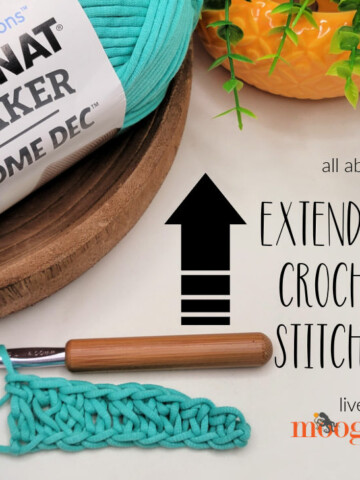
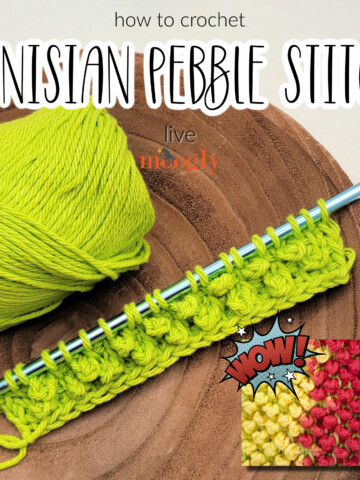



Pia Thadani
Mind. Blown. (Again!).
Tamara Kelly
😀 Thanks Pia!
Snow
How would this work in the round? I make crocheted hats using sc so there aren't a lot of holes so I can sew stuff on. My concern is that there would be a holey section where I join. Is there a way to get around this issue?
Tamara Kelly
This is a common question - and it's a little tricky, so you don't see it often. You can work them in a spiral instead of in joined rounds to get around the issue. The only other way I've seen is to insert the hook under both the horizontal bar to the right, and then again under the bar to the left, before pulling up the center loop. Tricky indeed!
Snow
Hi, thanks! Do you know of any good tutorials that show the spiral version? Thanks!
Tamara Kelly
I've never seen one - guess I should add it to my to do list!
Pat
Did you ever make a video for doing this in the round? I'm thinking that when making 'beanie hats' this would be a great stitch to use. I'm going to try the method of going to the right, then back to the left horizontal bar and see what happens 🙂
Tamara Kelly
Hi Pat! I'm afraid not, it's not a stitch I've done in the round myself.
Pat
This is the best site for teaching me new stitches. Thank you!
Scarlett M
Any recs on how to increase and decrease? Thanks!!
Tamara Kelly
I would increase and decrease the same way you would with regular dc sts! To increase, just work another LDC into the same st, linking to the previous one. To decrease, work the first LDC until there are 2 loops left on the hook, then make the next one linking to the first one "in progress." Is that clear?
Ash
This is seriously amazing, and I can't wait to try it out! LDC revolution here I come:D
Romy Williams
This addition to the standard double crochet stitch is totally awesome! I'm using it on a scarf for my son and it looks amazing. Thanks for sharing this with all of us!
Frances
I imagine if you wanted to make it look the same on each side, as you mentioned turning and the patterns looking different in rows, you could simply think of it as similar to bpdc and take the back horizontal bars instead of the front ones. Tricky, and I'd have to test it myself, but probably doable.
Tamara Kelly
Oh, now that's something to think about! Interesting!
Sarah
For a Tunisian take on this, check out the designer Aoibhe Ni on Ravelry - she also has some great videos on YouTube. I'd have to work the stitches side by side to figure out if there's a difference particularly between her linked uple stitches and regular linked crochet stitches, but she also works them in some really long linked stitches, multiples of 4-6 or sometimes more, and works the rows vertically across the width of the piece. Generally speaking I think she works the return row as double crochet, so the fabric is always the same on the "right" side and has a decided stripe to it.
I'm not sure whether or not this'll work but I happened to have had a picture of a swatch with me practising this that I uploaded to show someone else. This swatch has some increases and some rows of half treble (American half double) but it's largely done in the linked stitches in the way I learned from her:
Not shown in this swatch are her methods for working Tunisian lace in this method, because I'm still getting my brain round that. Well worth checking out, though!
I ended up back on Moogly again (I always end up here!) because I was trying to figure out the difference(s), if there are any, between these two styles. Either way, I really love the fabric it produces. I worked that swatch in a mercerised cotton and it has the most gorgeous feel and drape to it.
Sarah
Huh, evidently embedding the image didn't work - here's the link instead:
http://img.photobucket.com/albums/v172/sarahce/8D3B3CEF-4A68-41DB-B22D-F77212DE0987_zpsxajbpv2i.jpg
Hope that works.
And I also forgot to mention that the yarn is fingering weight.
Wendy J
Thank you for all your posts! This is great! I had started looking around to see if you had standing HDC, like the standing DC, but this looked good, so I meandered over here. I'm so tempted to frog the baby hat I just finished! I've alternated my rows between HDC & DC, because of the holes; this stitch is so nice! I won't have to do that any more. I love your site, and your many hints. (Off to find the standing HDC.)
Tamara Kelly
Standing HDC is a little different than the dc, but there's a video at https://www.mooglyblog.com/standing-half-double-crochet/ 🙂 Thanks so much Wendy!
Irene
It looked like you crocheted in the ridge of the chain. Is it easier to do it that way or to crochet in the chain?
Tamara Kelly
I think it's easier, and I like the finished bottom edge it creates - but everyone has their own preference!
Rosaerona
Thank you so much for this tutorial- I finally understand this stitch and can make a pattern I bought with it in but didn't explain it. Huzzah!
Tamara Kelly
Yay! Glad to have helped!
dawn bsrber
That is so cool! Can't wait ti fry it!
Tamara Kelly
😀 Thanks Dawn!
Kim
Tamara, I have tried & tried to decrease in ldc, but I'm not getting much of a bend in the valley. I'm trying to make a wave/ripple baby blanket using this stitch 'cause I like "no holes" in baby blankets. Is there any further explanation you can give or a video. I would really appreciate any help. Thank you.
Tamara Kelly
Hm, I can't say I've ever tried to decrease with this stitch before! I know you said you like no holes, but maybe skipping a stitch in the middle of the linked decrease would give the look you're going for? Or a decrease over 3 sts, instead of 2? It's something you'd have to play with a bit for sure.
muneer
Very interesting, i have not tried, surely i will, very straight forward tutorial thank you very very much
Tamara Kelly
Thank you!
Beth
This is awesome! YOU are awesome beyond belief! Thank you thank you for your tutorial! (I just pdf'd it!)
I came across a pattern with (ldc) abbreviated, but no full explanation of the stitch itself, just some cryptic nonsense about "insert hook, pull up loop, then into stitch, pull up loop, then yo and pull loop through 2 loops and then 2 more"... I was doing a modified cluster!
Tamara Kelly
🙂 I'm so glad it helped!
Beth
Oh, it did, absolutely 😀 thank you again!
Simone Neumann-salva
This is an outstanding explanation! I really love it... in fact I love it so much I would like to link it on my blog. I've written a simple free pattern for a crochet sweater completly in linked double crochet and would like to refer to your great blog. The text is not yet online, but you can see my patterns (and texts) on ravlery. At the moment my blog text are mostly in german, but on ravlery they are in english.
http://www.ravelry.com/designers/simone-neumann-salva
http://www.blissandblisters.com/category/haekeln/
I would really be glad, to link you! And I hope you excuse my bad english
Tamara Kelly
Hello Simone! Please do link it if it will help! Thank you! 😀
Simone Neumann-salva
Wundervoll 😀 and thank you for your great work
Catherine
I found the treble version of this stitch in the book, "Victorian Fancy Stitchery: Techniques and Designs" by Flora Klickmann, Oct. 17, 2003. I believe it's on page 80 and is called "treble connected stitch." The explanation of the stitch, though, is severely wanting and took me hours to figure out. When I did, I then worked out the dc and hdc versions myself. I've been trying to find online what other crocheters call this stitch, since we are such an innovative group, I was sure others have come up with this great stitch and are using it. I finally found your site and am very impressed with your great tutorial, explanations and pictures. This stitch is such an improvement on the regular dc stitch, because it removes the holes and makes a really tight fabric.
I recently made a beret with it - spiral technique - and instead of going into the previous row as usual, I went into the back loop on the previous row AND into the horizontal bar behind and below the back loop. It's kind of awkward and slow, but it makes the fabric even tighter.
Rita McLaughlin
thank you for your video. I have noticed at the very start you make the linked DC, but then skip a stitch and continue on in LDC. Next row you don't skip any stitches?
Rita
Tamara Kelly
I rewatched the video and didn't see the skip you're referring to?
Katajojo
I'm a literal reader and... literally.. you didn't say what was to be repeated. Am I to repeat just the part where you insert hook into NEXT stitch? Or am I supposed to repeat the: insert hook into 2nd, 4th, and next motif? How far do I go back in the instructions for the repeat. This was unclear as you just said "repeat" but didn't tell me what I'm repeating. Bc the first two you skkipped a chain. Is that in the repeat or not? Thanks
Katajojo
Also, I live in rural America and have no internet so can't watch videos. I need absolutely clearly written instructions bc I don't have the luxury of defaulting to a video. I'm lucky to even have cell service. Rural America runs of broadband only so watching videos is not available for many of us. Just letting you know why I need written instructions that are pristinely accurate. I can't go to the video for clarification. Thanks in advance
Tamara Kelly
I'm sorry about that, I have added more instructions to make it clearer! 🙂